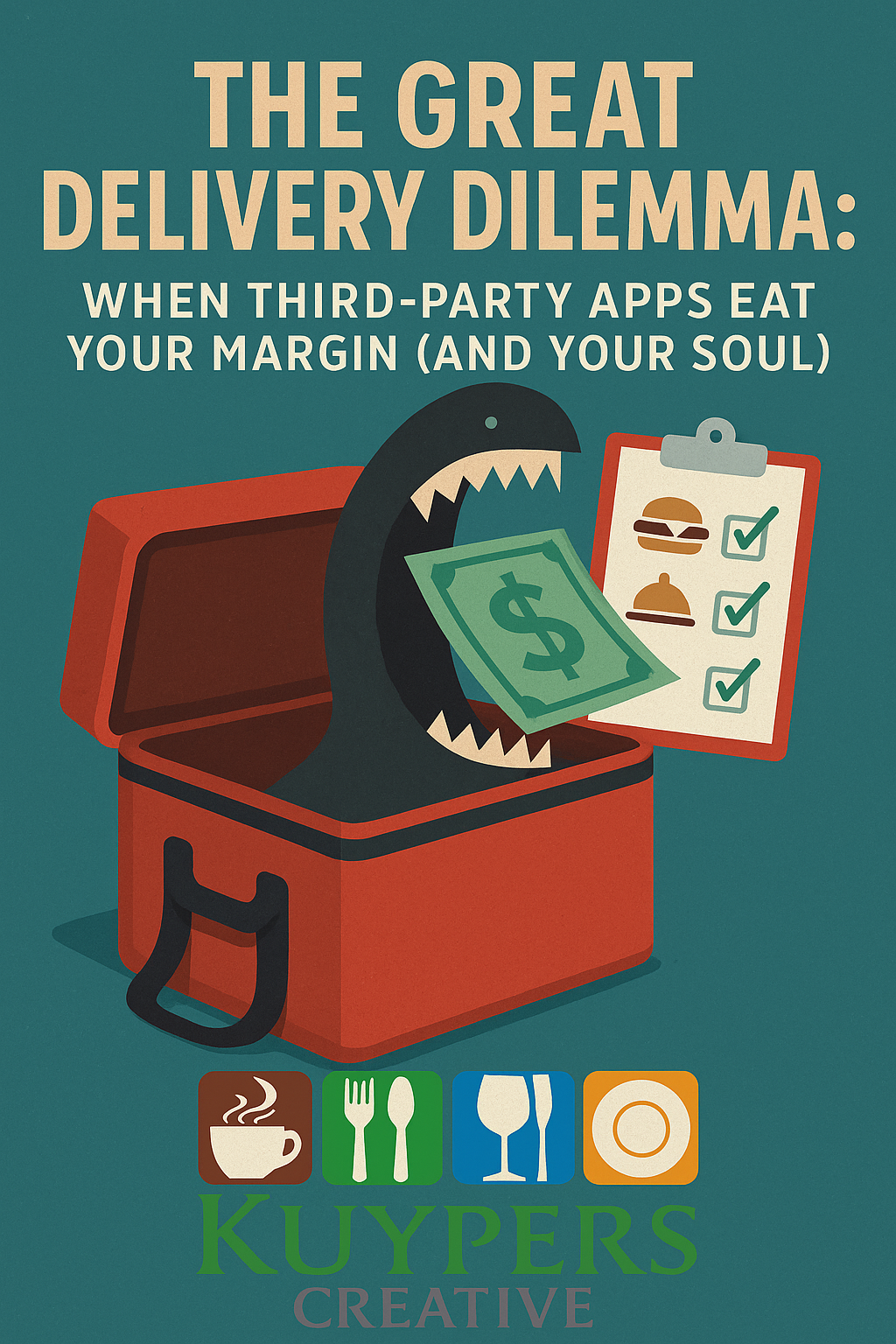The Dream That Became a Dumpster Fire
Remember when delivery apps were the future?
A magical world where you’d reach new customers, fill slow shifts, and print money while your POS sang sweet digital lullabies?
Yeah. About that.
What we actually got was:
- 30% commissions that make landlords look generous.
- Cold fries traveling 17 miles in the backseat of a Civic.
- Angry Yelp reviews about delivery times you didn’t control.
At first it felt like innovation.
Now it feels like a hostage situation with coupons.
How We Got Here (and Why We’re All Complicit)
I’ll admit it — I signed us up early.
The sales pitch was irresistible: “New revenue! Zero risk! Tech-powered growth!”
They left out the fine print: “We’ll own your customer data, set your delivery fees, and train your guests to be loyal to our app instead of your brand.”
We traded ownership for convenience — and in restaurants, that’s a dangerous deal.
Because once your guests think of themselves as Uber Eats customers, you’re no longer the restaurant. You’re the line item.
The Economics of a Broken System
Here’s a simple math exercise that’ll make you want to pour a drink:
Average third-party commission: 25–35%
Average restaurant net margin: 5–10%
Translation:
For every $100 of delivery sales, you might keep $5.
If your food cost runs high or you comp an order?
Congratulations — you just paid someone for the privilege of losing money faster.
Delivery isn’t a growth channel — it’s a marketing expense disguised as revenue.
You Can’t Control the App, But You Can Control the Experience
Here’s what I tell every client:
You may not own the platform, but you still own the experience.
Your packaging, your food quality, your follow-up — that’s your brand.
And that’s where the battle for loyalty happens.
Pro Moves for Surviving the Delivery Game:
1️⃣ Brand your packaging. Stickers, QR codes, inserts — anything that redirects attention back to you.
2️⃣ Control what travels. Not every dish should go on delivery. Fries die heroes; don’t send them into battle.
3️⃣ Follow up directly. Include a link for feedback that goes to your site, not the app.
4️⃣ Train your staff for “delivery hospitality.” Your handoff moments matter — the driver’s experience shapes the guest’s.
The Ghost Kitchen Mirage
Then came the next wave: ghost kitchens.
Slick, efficient, low-overhead — and yet somehow still full of invisible problems.
No foot traffic, no personality, and zero brand soul.
Without human connection, food becomes pure transaction.
I once consulted for a brand that launched three ghost kitchens in six months.
Revenue looked strong — until month eight, when customer repeat rate cratered.
Why?
No one felt loyal to a QR code.
Hospitality is oxygen. Take it away, and the business suffocates — no matter how good your margins look on paper.
The Branding Trap of Convenience Culture
Delivery apps trick us into thinking faster equals better.
But in hospitality, faster often means colder.
Your guests don’t crave speed — they crave connection.
They want to know your story, your chef, your vibe.
When you hand that relationship to a third-party platform, you’re outsourcing your brand equity.
You’re teaching guests that your name matters less than your discount.
How to Reclaim Your Digital Destiny
There’s a way out — and it doesn’t involve deleting all your delivery listings (though I’ve fantasized about it).
1. Build your own online ordering system.
Use tech partners that let you keep your data and brand the interface.
2. Use delivery apps as a funnel, not a finish line.
Offer first-time guests an incentive to order directly next time.
3. Tell your story everywhere.
If guests discover you on DoorDash, they should still know who you are before they hit checkout.
4. Measure real profitability.
Track contribution margin per channel. Delivery should serve dine-in growth, not cannibalize it.
Case Study: How One Restaurant Cut Delivery Costs 40%
One of my clients, a regional taco concept, was bleeding 27% commissions.
We built a first-party ordering site, re-trained their front-of-house team for “pickup hospitality,” and redesigned packaging with QR storytelling.
Within three months:
- 42% of their delivery orders moved to their own channel.
- Average ticket value rose 18%.
- Guest feedback improved because they felt connected again.
That’s not tech magic. That’s strategy — and respect for your own brand.
At Kuypers Creative, We Call It “Hospitality Control.”
At Kuypers Creative, we help restaurant brands take back their narrative — from delivery systems to marketing systems.
We design smart digital funnels that keep your profits (and your customers) in your ecosystem.
Because your brand deserves more than 70 cents on the dollar and a generic email from “Support@ThirdPartyApp.com.”
We don’t fight the future.
We just make sure it still has flavor.
Final Thought: Delivery Isn’t Evil — It’s Just Hungry
Delivery isn’t the villain.
It’s a tool — one that needs boundaries, purpose, and balance.
Use it to reach new guests.
Then use your brand to keep them.
Because no app can replace what truly drives hospitality:
connection, consistency, and a damn good story.
About Kuypers Creative
At Kuypers Creative, we help restaurant brands blend tech and heart — building sustainable systems, not short-term gimmicks.
👉 Visit KuypersCreative.com or connect with Robert W. Kuypers on LinkedIn.


